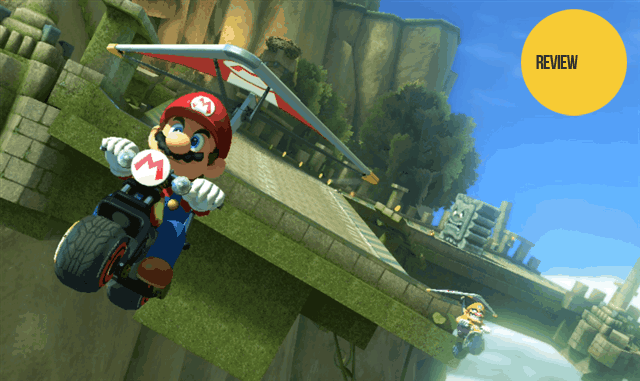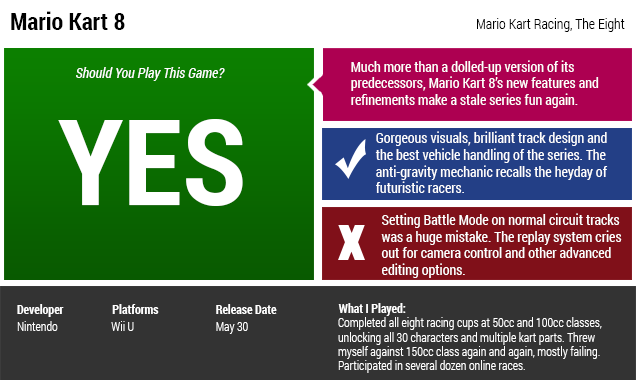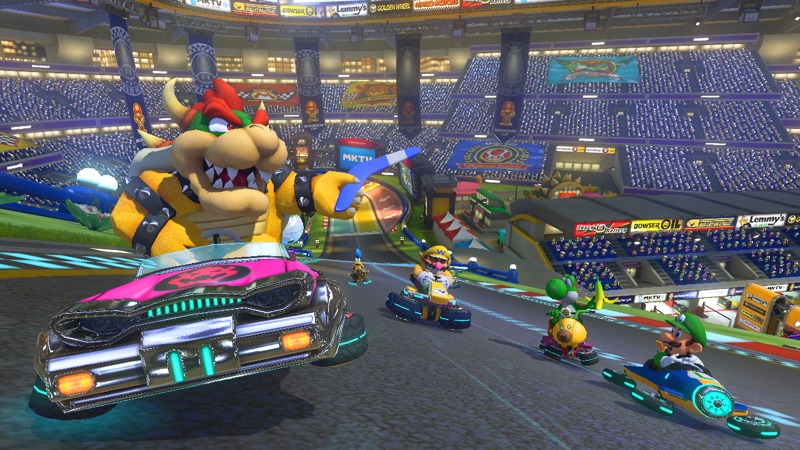Everyone has fond memories of the Mario Kart series" reads a blurb in the review materials for the eighth game in the series. Until now, I really didn't.
Mario Kart was never my game. When Super Mario Kart
was released for North American Super Nintendo systems in 1992, I was
already in love with another Nintendo EAD-developed racing game
featuring high-tech Mode 7 graphics — the progenitor of the futuristic
racing sub-genre, F-Zero. In the heart of a science
fiction-loving teenager, a super-flattened Mushroom Kingdom was nothing
compared to the flickering electronic cityscapes of the year 2560.
So instead of playing Super Mario Kart or Mario Kart 64, I was playing MegaRace, Wipeout, Extreme-G and Jet Moto. While my friends were forming two-man teams for Mario Kart Double Dash!!, I was playing... well, more Wipeout.

That's not to say I don't appreciate the appeal of the series. I've dabbled with each iteration of Mario Kart over the past couple of decades. It's just the closest I get to a fond memory is sitting in the bathroom playing Mario Kart 7
on the 3DS and marveling over how, despite daring new additions like
underwater segments and gliding, it didn't feel much different than
every other Mario Kart game I'd played.
I'm not attempting to incense the franchise's fan base. I'm merely establishing a baseline, so when I say that Mario Kart 8 feels different,
readers can appreciate what a profound statement I am making. Within
seconds of starting my first race, I could tell this was more than just
plain old Mario Kart with fancy HD graphics.
In the past I've struggled with Mario Kart driving controls,
struggling to grasp the correct timing of the series' signature drift
and boost system. Moments into my first run through the game's first
track, Mario Kart Stadium, I was powersliding around corners like a
semi-pro.
Vehicle handling is more intuitive than ever before, and adjusting
from a wide-sliding kart to the tight cornering of a motorbike is just a
matter of taking a quick test drive around a track. For a relatively
novice player the learning curve is incredibly short, which breeds the
confidence needed to take on tougher tracks at higher difficulties.
Never in my history with the series have I tore through all of the
courses (16 new and 16 revamped classics) with such enthusiasm.
It helps that the new batch of tracks has been designed with the
game's new anti-gravity feature in mind. When the road goes sideways,
turns upwards or spins upside-down, karts are transformed into high-tech
anti-grav vehicles, and suddenly I'm enjoying the best of both worlds —
futuristic hover-craft racing with some of the industry's most iconic
characters. It's exactly the tweak to the standard formula I was looking
for. I only wish the 16 updated classic tracks made more use of it.
Aside from the perfect arcade-style vehicle handling, ultra-inventive course design and the sharp visuals, Mario Kart 8
doesn't do much to change up formula established in previous games.
There are eight cups to challenge — four featuring brand new tracks and
another four consisting of revamped tracks from previous Mario Kart games. As per usual there are three racing classes, 50cc, 100cc and 150cc, each faster and more challenging than the last.
Racers greedily snatch at power-up boxes filled with devious devices
designed to ensure that no lead is every substantial enough that it
couldn't be stolen away in the blink of an eye. Annoying armaments like
the red and spiked turtle shells return, with a few new ones thrown in
for good measure. I particularly enjoy the rare Crazy 8, which spawns
eight power-ups at once that can be fired off in quick succession. It's
saved my bacon on more than one occasion.
Vehicle handling is more intuitive than ever before
Computer controlled racers are as brutal as ever in the higher
classes, and while new power-ups and enhanced handling make it slightly
easier to dodge their slings and arrows, it not enough to keep me from
yelling inappropriate words at my innocent television screen. They're
annoying, yes, but they also making playing alone much more dramatic.
One shouldn't seek respite in the games various online multiplayer
modes either. Even in its pre-release state, the competition (when I
could find it) was fierce. As I was being knocked to the rear of the
pack again and again while battling against real people from around the
globe, I found myself wishing massive lag spikes upon my competitors.
Unfortunately the online races were annoyingly lag-free, and my greatest
triumph was against a person who I am convinced was AFK the entire
race.
Thankfully Mario Kart 8 allows for custom multiplayer
sessions, giving players the ability to ban the most annoying power-ups
(most of them), stripping away the element of luck in favor of pure
skill. I sadly did not get to participate in an online tournament, but I
was impressed by the options for setting one up. Using a simple
interface, players can schedule weekly or daily tournaments with
relative ease, which I'm sure will come in handy once everyone else is
playing.
The only downside to online multiplayer (and multiplayer in general) was Mario Kart 8's Battle Mode.
Traditionally held in custom-crafted arenas, the balloon-popping
competitive game mode is instead played on normal circuit tracks.
Players drive around in circles, hoping to run into someone that's not
driving rapidly in the opposite direction. They hardly do. The tracks
are so large and winding they'd be lucky to see another person more than
once or twice in a given round. It's horribly tedious, borderline
unplayable.

Mario Kart 8 is more than just a pretty face, but damn what a pretty face it's putting forward. Some of the screenshots Nintendo released earlier this year
were so gorgeous, many felt they were bullshots, more attractive than
the game could possibly be. I'm pleased to report that, while they might
be taken from an angle players might never see in-game, this what Mario Kart 8 really looks like.

And it looks even better in action. Hair, facial and otherwise,
flutters in the wind as the characters race along the track. Each track
is filled with so much animated detail they're almost characters in
their own right. This is one of the best-looking games on the Wii U. It
makes me wonder what would happen if Nintendo started sharing the
secrets of making pretty games on its consoles with third parties.
Nowhere is the game's stunning beauty more evident than in Mario Kart TV,
a special area where players can edit and share their race replay
footage with the community. The player's most recent 12 races are
automatically saved, ready to be teased with a painfully restrictive
editor and thrust forth into the world.
Each track is filled with so much animated detail. This is one of the best-looking games on the Wii U.
I'd barely even call it an editor. Players can choose to fucos on
specific characters or events during the race, set the clip's run time,
turn off sounds and/or music, and that's about it. You can't clip a few
seconds, or change the camera angle. You can slow the playback down
(which looks amazing), but you can't save a slowed-down clip for
sharing.
I understand Nintendo likes to keep things simple and accessible, but
an advanced menu for those unafraid of video editing would have been
nice. Still, the fact that I am invested enough in this game to care
about video editing tools speaks volumes about my appreciation.
"Everyone has fond memories of the Mario Kart series." Like
the time I sat on the couch with my two-year-old twin boys, revving the
engine of Shyguy's motorbike as they counted down "Three, two, one, Go!"
in unison. Or staying up until two in the morning, flipping through my
highlight reels, making Mario jump a chasm again and again in slow
motion. Or the moment I realized that, thanks to wonderful design, tight
controls and exquisite visuals of Mario Kart 8, I finally had fond Mario Kart memories of my own.